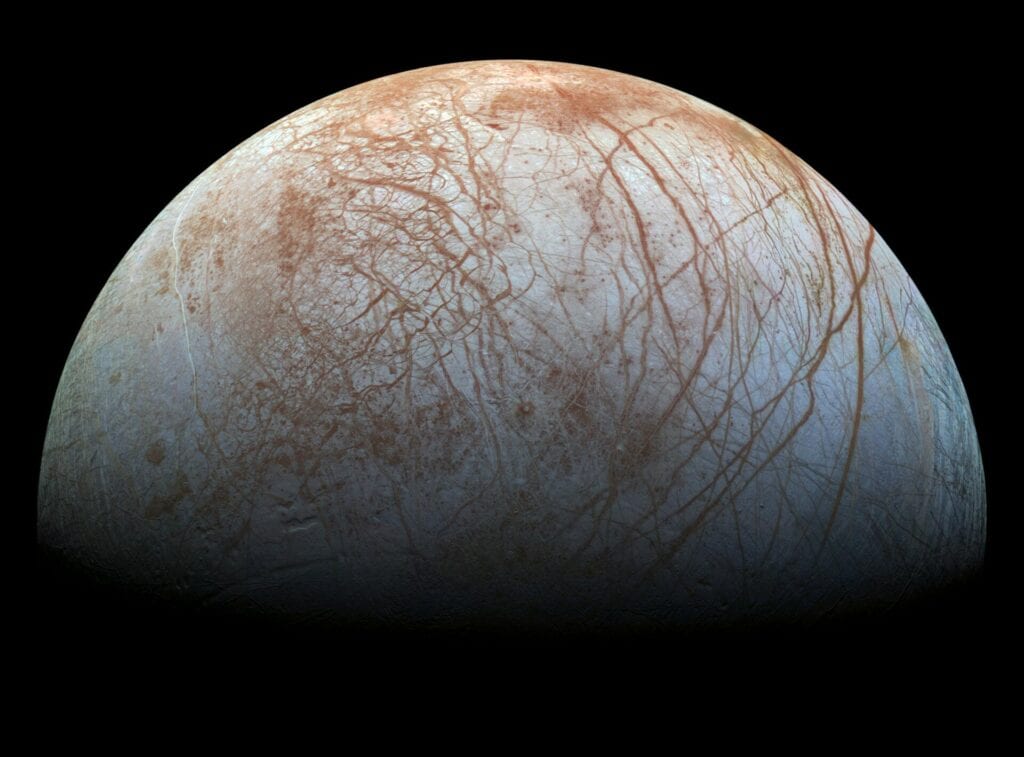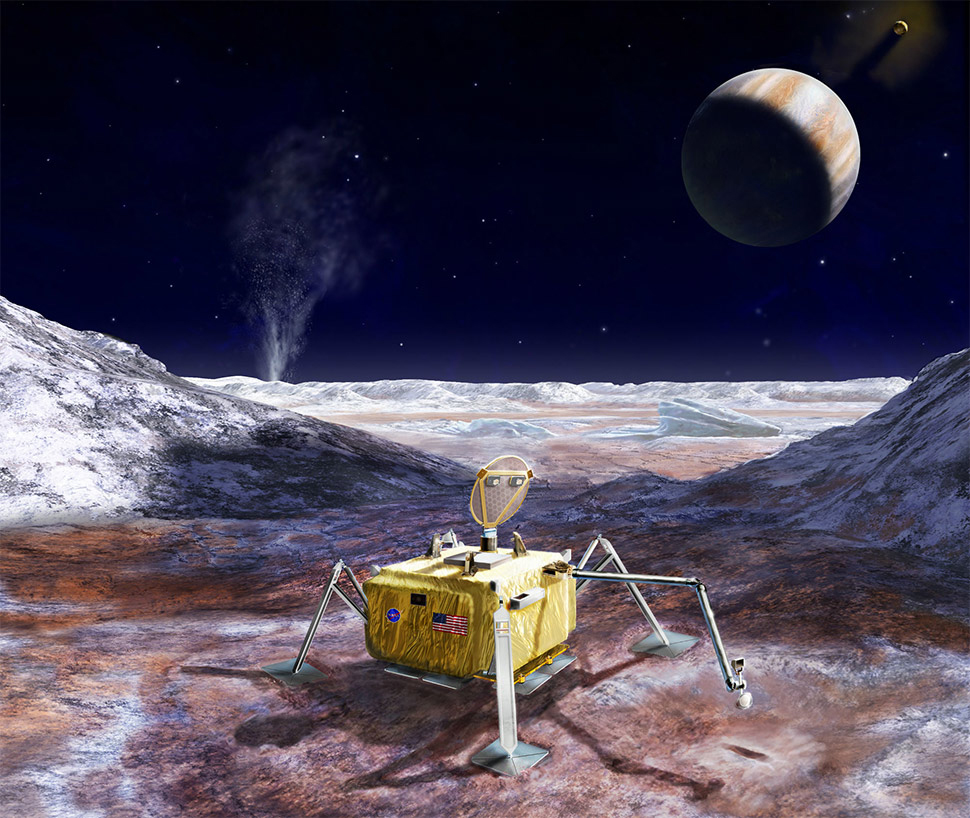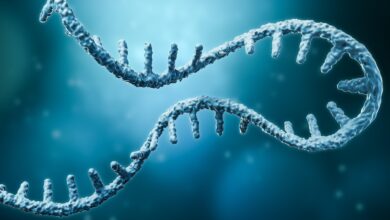Today’s NASA TV Livecast of New Discoveries on Jupiter’s Europa

“First, perhaps, it might be best to understand why anyone would want to land on Europa at all. Europa – the second of Jupiter’s four large satellites – is clearly a special place,” says Caltech’s Mike Brown, the Richard and Barbara Rosenberg Professor of Planetary Astronomy. “Ever since the time of the Galileo spacecraft nearly 2 decades ago, we have recognized that Europa’s fresh icy surface, covered with cracks and ridges and transform faults, is the external signature of a vast internal salty ocean.
NASA will announce new findings of Jupiter’s ocean-harboring moon Europa (shown above right along with the volcanic moon, Io) during a news conference at 2 p.m. EDT (1800 GMT) on Monday (Sept. 26). “Astronomers will present results from a unique Europa observation campaign that may be related to the presence of a subsurface ocean on Europa,” NASA officials wrote in a media advisory Tuesday (Sept. 20).
Read more: NASA Shuts Down Live Stream as UFO Enters Earth’s Atmosphere
In 2013, huge active plumes containing water vapor being released from the surface of Jupiter’s moon Europa were discovered shooting up 1200 kilometers. This sensational find was made using the NASA/ESA Hubble Space Telescope. Europa has been a focus of extraterrestrial research for some time, as there were clear indications that it harbors a liquid vast ocean beneath its icy crust. The plumes were not sighted again, however. The involvement of Hubble raises the possibility that Europa’s elusive plumes may finally have been spotted again.
The new information comes via NASA’s Hubble Space Telescope, agency officials said. We’ll post the conference live at dailygalaxy.com via NASA TV
The participants in Monday’s briefing are:
- Paul Hertz, director of the Astrophysics Division at NASA Headquarters in Washington.
- William Sparks, astronomer with the Space Telescope Science Institute in Baltimore.
- Britney Schmidt, assistant professor at the School of Earth and Atmospheric Sciences at Georgia Institute of Technology in Atlanta.
- Jennifer Wiseman, senior Hubble project scientist at NASA’s Goddard Space Flight Center in Greenbelt, Maryland.
Caltech astrobiologist Mike Brown regards Europa as one of the solar system’s best bets to host alien life. “I know, I know,” writes Mike Brown, author of the mikebrownsplanets blog, who specializes in the discovery and study of bodies at the edge of the solar system. “We have all been instructed by Arthur C. Clarke to attempt no landings on Europa. But if you did land on Europa, wouldn’t you like to know where to go? If you do, my graduate student, Patrick Fischer, has a paper coming out that you probably want to read.”
Brown is best known for his discovery of Eris, the most massive object found in the solar system in 150 years, and the object which led to the debate and eventual demotion of Pluto from a real planet to a dwarf planet. Feature articles about Brown and his work have appeared in the New Yorker, the New York Times, and Discover, and his discoveries have been covered on front pages of countless newspapers worldwide. In 2006 he was named one of Time magazine’s 100 Most Influential People.
Here’s his fascinating blog post on Jupiter’s Europa:

If, on a whim, you climbed down a crack on the surface of Europa and made your way down into the ocean (which, interestingly, might be something you actually could do; though it is more likely you would get stuck and squeezed to death; hard to tell) and then you figured out how to swim down to the rocky bottom something like 100 km below the base of the ice (a depth 10 times greater than the Marianas Trench, by the way) you would instantly be able to answer what to me is one of the most interesting mysteries about Europa. What is happening at the boundary of the rocky core and the ocean? The answer has profound effects on the type of world that Europa ultimately is.
What might be happening down there? The least interesting possibility is that the bottom of the ocean is a stagnant, inactive place: water on top; rock on bottom; a little dissolution of the rock into the water in between, but, otherwise, with not much going on. A world like this wouldn’t have much of a source of chemical energy in the ocean, and it’s hard to imagine it could support even the most elementary types of life. If you had taken all of that effort to swim all the way to this cold dark dead ocean bottom, you might start to ask yourself whether or not it was even worth it.
The most interesting possibility – at least the most interesting possibility that I can think of – is that the rocky bottom of the ocean is almost like a miniature Earth, with plate tectonics, continents, deep trenches, and active spreading centers. Think about mid-ocean ridges on Earth, with their black smokers belching scalding nutrient-rich waters into a sea floor teaming with life that is surviving on these chemicals. It doesn’t take much of an imagination to picture the same sort of rich chemical soup in Europa’s ocean leading to the evolution of some sort of life, living off of the internal energy generated inside of Europa’s core. If you’re looking for Europa’s whales – which many of my friends and I often joke that we are – this is the world you want to look for them on.
Sadly, no one is going to climb down through a crack and then swim to the bottom of Europa’s ocean for a long long time, so this is where landing on the surface comes in. If the chemicals that are dissolved inside of the ocean could somehow make it to the surface, we could learn a lot about what is going on deep inside of Europa just by analyzing a little a sample of the surface.
OK,then, let’s go land! But where? You probably only get one shot at a lander, and you probably don’t get to move once you land, so you had better pick the right spot. The announcement a couple of years ago, that plumes of water jetting from Europa’s south pole had been discovered by the Hubble Space Telescope, seemed to have answered the question: land at the pole, and wait for plumes to rain down upon you (or, perhaps even more easily, fly through the plumes and collect samples without even landing!).
The bad news, however, is that the plumes now appear to be elusive at best and non-existent at worst. Since their initial detection no one has been able to see them again. Are they (very) sporadic? Was the initial detection an unfortunate spurious signal that was misinterpreted? No one yet knows, but no one today is going to count on plumes for measuring the chemical composition of the ocean.
Luckily, our new paper shows that we don’t need plumes to sample the interior, and we even conveniently point out a potential landing area that is large enough to easily target with your favorite lander.
First, how do you find a landing site? What we are actually doing is simply mapping the composition of the ices across the surface of Europa. Such mapping has been going since the time of the Galileo mission, but with modern telescopic instruments and high spatial resolution adaptive optics systems on large telescope on Earth, we can do a better job of making global scale maps than the Galileo spacecraft ever could. In the earlier Galileo mapping efforts and in our own early analyses of our own data, we concentrated mainly on dividing the surface of Europa into an ice component and a non-ice component and then trying to figure out what the non-ice component was.

Like the earlier Galileo analyses, we found that the dominant non-ice component is sulfuric acid that is created when sulfur (ultimately derived from volcanoes on Io!) bombards the water ice on the surface of Europa. We also found, though, that some of the non-ice material was magnesium sulfate – Epsom salts, in fact – which we suggested indicated a magnesium source coming from inside of Europa’s ocean that then mixes with the incoming sulfur.
Patrick Fischer, in his new analysis, decided to take these ideas one step further. He wanted to know if there is anything else on the surface of Europa besides just the water ice and the sulfur products. To do so, he took the spectra of nearly 1600 separate spots on the surface of Europa and started looking for anything unusual that stood out. The answer was…… maybe. Staring at that many spectra you’re bound to find something to catch your eye. He needed a more rigorous method to group the spectra together, and eventually he developed a very clever new mathematical tool which allows you to take an arbitrary collection of spectra and automatically, with no preconceived human biases, classify them into an arbitrary number of distinct spectra, and present maps of where those materials are present on the surface.
When he asked the tool to give him to find the two most distinct spectra on the surface of Europa, he reproduced the ice plus sulfur products distributions that had been known for decades. When he asked for a third distinct spectrum, though, a large region on the surface of Europa suddenly popped out as being composed of material unlike the ice or sulfur products of the previous map. Staring back and forth between the composition map he had just made and a geological map of the surface of Europa, he was startled to realize that he had nearly precisely mapped out one of the largest regions of what is called “chaos terrain” on Europa.
Mapping the composition of the surface of Europa has shown that a few large areas have large concentrations of what are thought to be salts. These salts are systematically located in the recently resurfaced “chaos regions.” One such region, named Western Powys Regio, has the highest concentration of these materials presumably derived from the internal ocean, and would make an ideal landing location for a Europa surface probe.
On Europa, “chaos terrains” are regions where the icy surface appears to have been broken apart (NASA image above) , moved around, and frozen back together. Observations by Caltech graduate student Patrick Fischer and colleagues show that these regions have a composition distinct from the rest of the surface which seems to reflect the composition of the vast ocean under the crust of Europa.
Chaos terrain was noticed early on in the Galileo mission as regions which look like the surface of Europa has become cracked and jumbled and – intriguingly – perhaps even melted in recent times. If you had to vote for a location on Europa where ocean water had recently melted through and dumped its chemicals on the surface, you would vote for chaos terrain. And now Patrick had found that on large regional scales chaos terrain has a different composition than the rest of the surface of Europa!
And what do the spectra tell us that the unique composition of this chaos terrain is? Sadly, we can’t yet tell. To date, we have not found unique compositional indicators in the spectra of this region, though our search is ongoing. Our best bet, though is that we are looking at salts left over after a large amount of ocean water flowed out on to the surface and then evaporated away. The best analogy would be to large salt flats in desert regions of the world. Just like these salt flats, the chemical composition of the salt reflects whatever materials were dissolved in the water before it evaporated. On the Earth, salt flats can contain any number of exotic salts, depending on the surrounding rock chemistry. On Europa, the salts will tell about the rock chemistry, too, though the rock is the material far below at the base of the ocean.
We think, then, that we have found a giant salty patch on the surface of Europa, and very likely the region of most recent resurfacing and undisturbed chemistry. I have tried very hard to get Patrick to call this salty patch Margaritaville, but he does not think that graduate students are quite established enough to make jokes like that. I’ll make it for him, though. And I will tell you: attempt a landing there!
Margaritaville will not only have salts that tell you about the rock-ocean interaction, but it will also have samples of everything else that the ocean has to offer. Is there organic chemistry taking place in the oceans? Look in Margaritaville. Carbonates? Margaritaville. Microbes? Definitely Margaritaville. All of these are best searched for with the types of instruments currently roving around on Mars, where you grab a sample, put it into a machine, and read back out the chemical composition.
But don’t forget to bring the cameras along, too, just to see what else is lying around. The jumbled and exotic icy terrain is bound to be a spectacular site up close. You might get lucky and see a plume shooting off into the sky in the distance. And maybe, just maybe you’ll even find a few whale bones lying around.




